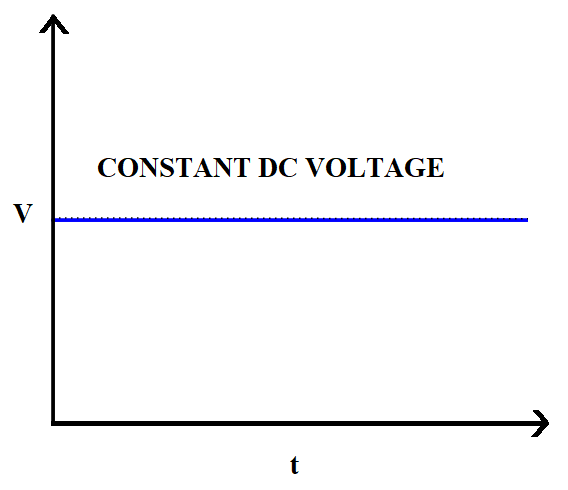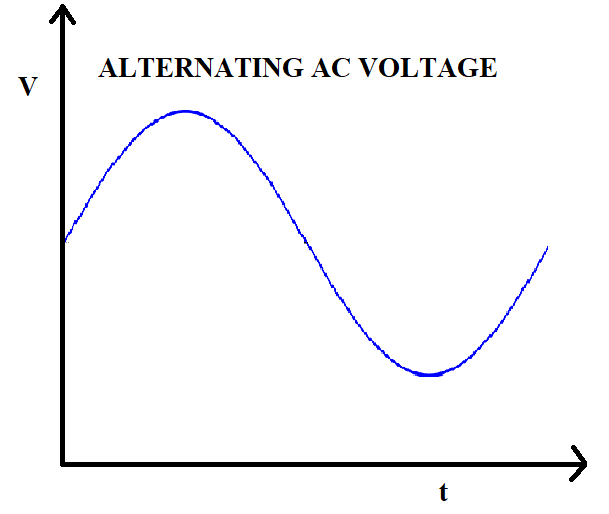
The frequency of direct current (DC) is:
$A)0Hz$
$B)25Hz$
$C)75Hz$
$D)100Hz$
Answer
576k+ views
Hint: Direct current (DC) is the flow of electric charge in one direction. Frequency of current refers to the number of times the direction of flow of electric charge, gets reversed, in one second. A direct current can be converted to alternating current and vice versa.
Complete step by step answer:
We know that current is the flow of electric charge. Current is mainly differentiated into AC current as well as DC current, on the basis of direction of flow of electric charge. A direct current (DC) source produces a constant current, and thus, a constant voltage whereas an alternating current (AC) source produces an alternating current, and thus, an alternating voltage. The most common examples of DC current sources are batteries and torchlights.
DC current refers to the unidirectional flow of electric charge. In a battery, electrons move from negative region to positive region, to produce DC current from positive region to negative region. If alternating current (AC) is flowing through a circuit, the direction of current gets reversed at definite intervals. But if direct current (DC) is flowing through a circuit, the direction of current flow remains the same, in a single direction.
Frequency of alternating current (AC) refers to the number of times, the current reverses its direction, in one second. It is said that the frequency of alternating current is $60Hz$, if the current reverses its direction $60$ times, in one second. Frequency of direct current (DC) is zero because the flow of current is unidirectional here. There is no scope for a reverse in direction and the frequency of direct current (DC) always remains zero. Additionally, the magnitude of current produced from a DC current source is always constant whereas that produced from an AC current source keeps on alternating. Thus, a DC source produces a constant voltage while an AC source produces an alternating voltage as shown in the following figures.


Therefore, the correct answer is option $A$.
Additional information:
An AC current can be converted to a DC current with the help of a rectifier. At the same time, a DC current can be converted to an AC current with the help of an inverter.
Note:
Students need to understand the type of current used in daily life situations. For example, as already mentioned, a battery generates DC current. Our mobile phones and chargers too, use DC current. So do electric vehicles and telecommunication networks. Another important application of DC is high voltage direct current (HVDC) power transmission system, in which DC is used for bulk transmission of power. This method of using HVDC transmission for long distance transmission is cost efficient and suffers less energy loss.
Complete step by step answer:
We know that current is the flow of electric charge. Current is mainly differentiated into AC current as well as DC current, on the basis of direction of flow of electric charge. A direct current (DC) source produces a constant current, and thus, a constant voltage whereas an alternating current (AC) source produces an alternating current, and thus, an alternating voltage. The most common examples of DC current sources are batteries and torchlights.
DC current refers to the unidirectional flow of electric charge. In a battery, electrons move from negative region to positive region, to produce DC current from positive region to negative region. If alternating current (AC) is flowing through a circuit, the direction of current gets reversed at definite intervals. But if direct current (DC) is flowing through a circuit, the direction of current flow remains the same, in a single direction.
Frequency of alternating current (AC) refers to the number of times, the current reverses its direction, in one second. It is said that the frequency of alternating current is $60Hz$, if the current reverses its direction $60$ times, in one second. Frequency of direct current (DC) is zero because the flow of current is unidirectional here. There is no scope for a reverse in direction and the frequency of direct current (DC) always remains zero. Additionally, the magnitude of current produced from a DC current source is always constant whereas that produced from an AC current source keeps on alternating. Thus, a DC source produces a constant voltage while an AC source produces an alternating voltage as shown in the following figures.


Therefore, the correct answer is option $A$.
Additional information:
An AC current can be converted to a DC current with the help of a rectifier. At the same time, a DC current can be converted to an AC current with the help of an inverter.
Note:
Students need to understand the type of current used in daily life situations. For example, as already mentioned, a battery generates DC current. Our mobile phones and chargers too, use DC current. So do electric vehicles and telecommunication networks. Another important application of DC is high voltage direct current (HVDC) power transmission system, in which DC is used for bulk transmission of power. This method of using HVDC transmission for long distance transmission is cost efficient and suffers less energy loss.
Recently Updated Pages
Master Class 12 Business Studies: Engaging Questions & Answers for Success

Master Class 12 Economics: Engaging Questions & Answers for Success

Master Class 12 English: Engaging Questions & Answers for Success

Master Class 12 Maths: Engaging Questions & Answers for Success

Master Class 12 Social Science: Engaging Questions & Answers for Success

Master Class 12 Chemistry: Engaging Questions & Answers for Success

Trending doubts
The pH of the pancreatic juice is A 64 B 86 C 120 D class 12 biology CBSE

Explain sex determination in humans with the help of class 12 biology CBSE

Draw ray diagrams each showing i myopic eye and ii class 12 physics CBSE

Which state in India is known as the Granary of India class 12 social science CBSE

Using Huygens wave theory derive Snells law of ref class 12 physics CBSE

Dihybrid cross is made between RRYY yellow round seed class 12 biology CBSE




